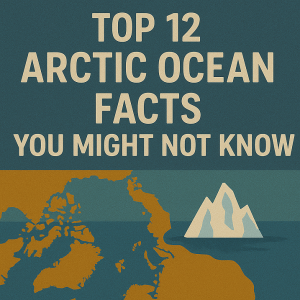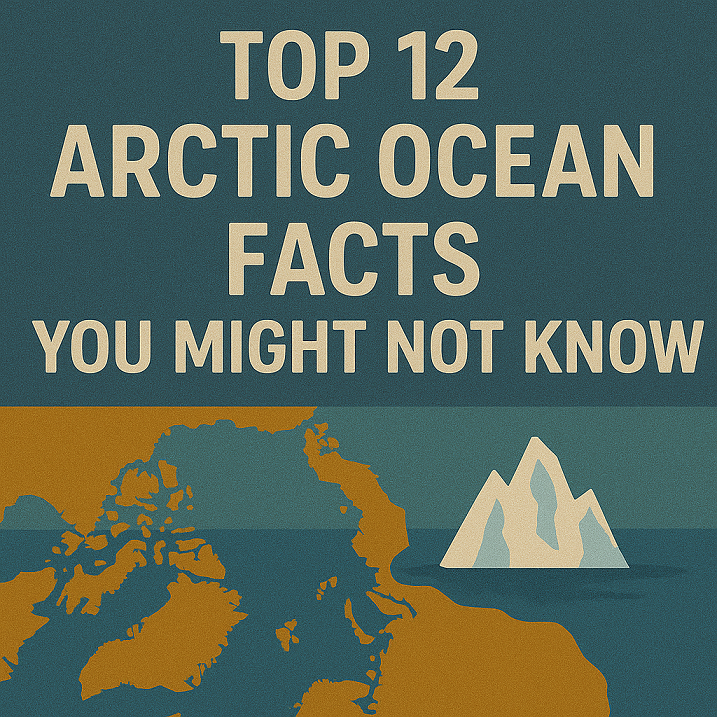 Dive into 12 surprising Arctic Ocean facts that reveal its critical role in shipping, climate science, and geopolitics. Discover little-known insights about the world’s smallest, coldest, and fastest-changing ocean.
Dive into 12 surprising Arctic Ocean facts that reveal its critical role in shipping, climate science, and geopolitics. Discover little-known insights about the world’s smallest, coldest, and fastest-changing ocean.
The Arctic Ocean is more than a frozen frontier. Beneath its icy surface lies a story of ancient currents, climate battles, and international maritime strategy. Stretching across the top of the globe, this smallest of the world’s oceans is fast becoming the center of geopolitical attention, environmental research, and shipping innovation. This article explores 12 astonishing facts about the Arctic Ocean that every maritime professional, student, and enthusiast should know.
Why the Arctic Ocean Matters in Modern Maritime Operations
For centuries, the Arctic Ocean was mostly inaccessible—a domain for icebreakers, explorers, and polar bears. But with ice melting faster than ever due to climate change, it is quickly transforming into a new maritime highway.
According to the Intergovernmental Panel on Climate Change (IPCC) and IMO, Arctic sea ice is declining at an average rate of 13% per decade. This trend has unlocked new seasonal routes like the Northern Sea Route (NSR) and the Northwest Passage, cutting shipping times between Asia and Europe by thousands of kilometers.
The Arctic now plays a critical role in:
- Shipping and logistics
- Climate science and oceanography
- Oil and gas exploration
- Geopolitical navigation rights and sovereignty claims
It’s the Smallest and Shallowest of the World’s Oceans
Covering around 14 million square kilometers, the Arctic Ocean is smaller than the Indian, Pacific, Atlantic, and Southern Oceans. It is also the shallowest, with an average depth of just 1,205 meters (compared to over 3,900 meters for the Pacific).
Despite its size, it holds enormous ecological and climatological importance.
The Arctic Ocean Is Covered by Sea Ice—But It’s Vanishing Fast
Sea ice is one of the Arctic’s defining features. Unlike glaciers or ice shelves on land, sea ice floats on ocean water and expands in winter, then melts back in summer.
In September 2023, satellite data from NOAA showed Arctic sea ice at its sixth-lowest extent on record. Scientists predict that by 2050, the Arctic could experience its first ice-free summer (World Meteorological Organization).
For maritime navigation, this means both opportunity and risk. Less ice allows easier passage, but increases wave height, ice fragment hazards, and ecological disturbance.
The Arctic Ocean Has Its Own Shipping Code
Due to its extreme conditions, the Arctic Ocean falls under a specialized regulatory regime known as the Polar Code, adopted by the IMO and entered into force in 2017.
The Polar Code sets mandatory standards for:
- Ship design and equipment
- Crew training
- Search and rescue planning
- Environmental protection measures
Vessels operating in the Arctic must comply with this code, including updated STCW training for polar operations and onboard ice navigation simulations.
It Hosts One of the Fastest Growing Shipping Corridors
The Northern Sea Route (NSR) along Russia’s Arctic coast is emerging as a major shipping lane. In 2023, over 36 million tonnes of cargo were transported through the NSR (Russian Ministry of Transport).
Compared to the Suez Canal route, NSR reduces travel between East Asia and Northern Europe by up to 40%.
Example: LNG carriers like those operated by Sovcomflot and Novatek use ice-class tankers year-round to export Russian gas to Asia via the NSR.
It Has a Unique Ocean Circulation System
The Arctic Ocean is linked to global climate through the thermohaline circulation, often called the “global conveyor belt.”
Cold, salty water in the Arctic sinks and flows southward, driving deep-ocean currents. This regulates temperature patterns across the Atlantic and influences monsoons, hurricane formation, and fish migrations.
Changes in Arctic salinity due to freshwater ice melt could disrupt this system, with global consequences.
It’s a Rich Source of Oil, Gas, and Rare Minerals
The U.S. Geological Survey (USGS) estimates the Arctic holds 13% of the world’s undiscovered oil and 30% of its natural gas.
Key regions include:
- Barents Sea (Norway/Russia)
- Beaufort Sea (Canada/USA)
- Kara Sea (Russia)
As sea ice retreats, interest in subsea resource exploration is rising. But environmental and legal concerns persist, especially under the United Nations Convention on the Law of the Sea (UNCLOS).
The Arctic Ocean Borders Five Nations
The Arctic Ocean touches the shores of:
- Canada
- Russia
- Norway
- Denmark (via Greenland)
- The United States (Alaska)
Each country claims Exclusive Economic Zones (EEZs), but overlapping interests have led to disputes, particularly over the Lomonosov Ridge and extended continental shelves.
International negotiations are ongoing under UNCLOS Article 76 procedures.
It Supports Indigenous Communities and Traditional Navigation
The Arctic is home to Inuit, Sámi, Chukchi, and other Indigenous peoples. These communities rely on sea ice for hunting, fishing, and cultural travel.
Traditional navigation techniques, such as reading ice patterns and celestial positioning, are passed down through generations.
Modern climate shifts are disrupting these systems, prompting collaborative research by groups like the Arctic Council and The International Union for Circumpolar Health.
Submarines and Military Activity Are Common
Due to its strategic position, the Arctic has long been a theater for military operations, especially during the Cold War.
Nuclear-powered submarines from Russia, the US, and NATO allies frequently operate under the ice.
In 2021, three Russian Navy submarines surfaced simultaneously through Arctic ice in a show of force. Arctic defense initiatives are increasingly tied to IMO Arctic Maritime Safety and search-and-rescue protocols.
It Hosts the World’s Largest Icebreaker Fleet
Russia operates the world’s most advanced icebreaker fleet, including nuclear-powered ships like the Arktika and Sibir. These vessels enable year-round navigation through thick sea ice.
Finland, Sweden, Canada, and the US also maintain icebreaker fleets, crucial for port access, scientific missions, and commercial routes.
In 2024, China launched Xue Long 2, a polar-class research icebreaker capable of Arctic and Antarctic expeditions.
A Biodiversity Hotspot Under Threat
While extreme, the Arctic Ocean is home to over 5,000 species, including:
- Narwhals
- Polar bears
- Arctic cod
- Zooplankton that sustain entire food chains
Warming waters and increased ship traffic threaten these fragile ecosystems. According to the Marine Pollution Bulletin, underwater noise and microplastic pollution are rising rapidly in Arctic zones.
A Global Lab for Climate Science
From floating ice observatories to seabed cores, the Arctic is a hotspot for climate research.
Projects like MOSAiC (Multidisciplinary drifting Observatory for the Study of Arctic Climate), the largest polar expedition in history, have generated critical data on:
- Ocean-atmosphere interaction
- Methane release from permafrost
- Sea-ice albedo feedback
This research informs IMO climate adaptation strategies, the UNFCCC, and global carbon budgeting.
Frequently Asked Questions (FAQ)
Can any ship sail in the Arctic Ocean? No. Only ice-strengthened ships certified under the Polar Code can operate safely, especially during winter.
How long is the Arctic shipping season? Typically from July to October, depending on ice conditions. Some ice-class vessels operate year-round.
Is Arctic shipping legal? Yes, but it’s governed by international regulations like the Polar Code, UNCLOS, and national laws of coastal states.
Are there ports in the Arctic? Yes. Examples include Murmansk (Russia), Churchill (Canada), and Longyearbyen (Norway).
How cold is the Arctic Ocean? Water temperatures range from -2°C to 3°C. Subzero temps are possible due to the salt content lowering the freezing point.
What is the deepest point in the Arctic Ocean? The Molloy Deep in the Fram Strait is its deepest point, at around 5,550 meters.
Conclusion
The Arctic Ocean may seem remote, but its influence stretches across every ocean current, shipping lane, and climate policy on the planet. From icebreaker convoys and Polar Code protocols to Indigenous wisdom and climate science, the Arctic is more connected to our lives than most imagine.
As the region transforms under climate pressure, maritime professionals, students, and global citizens alike have a role to play in shaping its future. Whether navigating new routes or protecting fragile habitats, the Arctic Ocean demands both respect and responsibility.
References
- IMO Polar Code: https://www.imo.org/en/MediaCentre/HotTopics/Pages/polar-default.aspx
- NOAA Arctic Report Card 2023: https://www.arctic.noaa.gov/Report-Card
- IPCC Special Report on the Ocean and Cryosphere: https://www.ipcc.ch/srocc/
- Marine Pollution Bulletin: https://www.sciencedirect.com/journal/marine-pollution-bulletin
- UN Convention on the Law of the Sea (UNCLOS): https://www.un.org/Depts/los/
- Russian Arctic Shipping Statistics: https://mintrans.gov.ru/en/
- Arctic Council: https://www.arctic-council.org/
- US Geological Survey (USGS) Arctic Resources: https://www.usgs.gov/
- MOSAiC Expedition Overview: https://mosaic-expedition.org/
- World Meteorological Organization (WMO): https://public.wmo.int/en
- International Maritime Organization (IMO) Arctic Resources: https://www.imo.org/en/OurWork/Safety/Pages/polar-code.aspx

